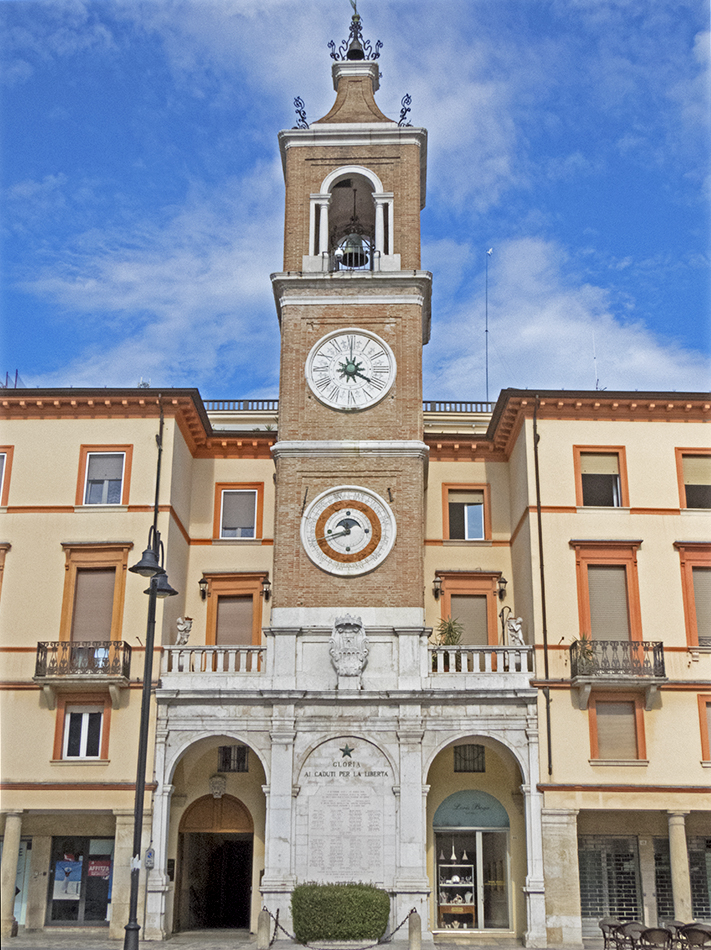
Although time and its measurement is a fundamental component of human life, a special type of clock which takes matters to the next level is the so-called
astronomical clock and whose purpose is not to measure time per se but to convey astronomical information and, in particular, the relative position of the
Sun and Moon as well as the zodiacal constellations and, in some cases, the position of the planets all as a function of time.
The oldest such effort to effectively emulate the overhead celestial sphere (ie a mini-planetarium) is the
Antikythera Mechanism which was discovered in 1901 totally by
accident by sponge divers off the coast of the Greek island of Antikythera. It has been dated to approximately 80 BC and it is believed to be the work of
Poseidonius of Rhodes. The Antikythera Mechanism is currently on display
at the National Archaeological Museum in Athens, Greece.
Note: The city of Rimini with a population of approximately 150,000 residents sits on the coast of the Adriatic Sea and is
in the region of the Emilia-Romagna area of northern Italy. Known world-wide for its beautiful beaches, the city is dated to 268 BC and includes various
impressive archaeological ruins such as the 10.4-meter tall Arch of Augustus (27 BC), the Tiberius bridge (21 AD) with five arches and which spans the
Marecchia river and the ancient amphitheater erected in the second century AD (based on the coins found in its walls depicting Hadrian).
Located in the heart of Rimini's historic center, one will find the Piazza Tre Martiri and which was named in honour of three resistance fighters who
were executed in 1944 for their efforts against the German occupation forces. Along with a statue of Caesar on the west side of the plazza, one will
immediately notice the impressive Torre dell'Orologio (Clock Tower) on the northern side which includes a plaque in honour of the aforementioned martyrs
at its base and an impressive astronomical clock comprised of two dials depicting the calendar date, the zodiac using terracotta figurines as well as the
phase of the moon and its age (synodic month). The clock tower was originally constructed in 1543 but was later rebuilt by Giovan Francesco Buonamici in
1753 to also include a calendar dial. The absolute top of the clock tower was ruined by an earthquake in 1875 and eventually restored in 1933.
The upper (white) dial is comprised of two hands and which are used to denote the time of day using a 12-hr dial (ie. I through XXII) and in contrast to
many other similar astronomical clocks at the time which insisted of a 24-hr dial (ie. I through XXIV). The upper dial also has designations for mid-hour
and which are marked using lily flowers.
The second and lower dial is of much greater interest and significance. The outer ring is used to document the twelve months of the year with January at
approximately the 1 o'clock position. The next inner dial divides each month in 10-day intervals with demarcations for the 10th, 20th and 30th or 31st day
of each month. The next inner ring depicts the various signs of the zodiac using terracotta figurines and followed by a ring with four circles at 90-degree
intervals presumably indicating the four seasons of the year. A large bronze pendant spans these rings so as to effectively describe the date of the month as
well as the Sun's position amongst the constellations of the zodiac. Finally, the innermost ring is split into 29 segments using the arabic numerals 1 through
29 and a smaller pendant is used to note the age of the moon (synodic month).
Note: For a view of the astronomical clock using much greater focal length for both dials combined and individually, please click
here,
here and
here.
Note: For additional results involving astronomical clocks from around the world, please click
here.
|
Body: Sun Mass: 332,900 x Earth Mass Eq Diameter: 109.1 x Earth Distance: 149 million km RA / Dec: 23h 41m 41s / +89° 19' 51" Diameter: 32.16' Magnitude: -26.8 |
 |
Date: Sept 16, 2023 Location: Piazza Tre Martiri, Rimini, Italy Equipment: Canon PowerShot SX60 HS @ 7.80 mm / f8.0 Exposure: 1 x 1/1000 sec ISO 400 RAW Image Format 4768x3516 Image Size Continuous Servo Mode Manual Mode Software: Photoshop CS6 Processing: Brightness/Contrast Resampling JPG Compression |